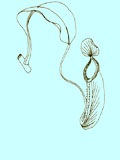

 |
 |
From the (tea) bar...... |
See the pyramids
by John R. Fellowes
Richard Corlett struggled in the last Porcupine! to come up with a non-trivial generalisation without exceptions in ecology. Since he has made this point before I feel impelled to mention one. Charles Elton’s ecological “Pyramid of Numbers” admittedly had exceptions, but once adapted by Lindeman and Hutchinson into an energy pyramid, it became as firm as the Second Law of Thermodynamics in which it was rooted: as you hop up the trophic levels, total energy diminishes. The extent of diminishment is variable, but it is substantial, and is something like an order of magnitude. Perhaps Richard would exempt this as physics in ecology’s clothing, but surely anything to do with trophic levels is ecologists’ domain. I’m not aware of any exceptions (I’m sure the physicists would be keen to know if there are), which leaves us the question: is it non-trivial?
Not in ‘pure’ ecology. In general terms, the rule has been used, as Paul Colinvaux put it, to explain “why big fierce animals [carnivores] are rare”. Less famously, it recently prompted Jean Tobin to question the role of ants in tropical forest canopies, those most species-rich of habitats, which they dominate numerically. Ants, unlike termites, were always supposed to be mainly secondary consumers, but there is simply too much of the animal biomass (and energy) packaged as ants for this to work. He concluded that we had grossly overlooked the importance of plant-derived fluids and/or fungi to these creatures.
But the non-triviality is of more immediate concern to our species than that. With six billion humans on this planet, it makes a great deal of difference where we ourselves sit on the trophic tree. Most agricultural land is now tied up providing for livestock. Occupying a higher trophic level than necessary demands either (a) higher primary production; (b) taking someone else’s share; and/or (c) eating away another natural ecosystem. Recently in western Guangxi we visited areas that are, according to China’s maps, strongholds of her diverse tropical forests. Indeed they were, until the last decade or so; vast genetic reservoirs of our potential food plants and insect allies. Now they are gone; the hills, instead, are growing corn. Why? To feed pigs. Increasing meat consumption in China’s cities, Hong Kong included, demand an additional 20 million pigs each year. We are destroying biodiversity as we eat.
Historically the Chinese (and Asians in general) derived most of their protein from plant matter. But expectations have changed. Meat consumption in China rose from 20 million tonnes in 1991 to a staggering 63 million in 1998. Opinions differ on how to improve yields, and on how far they can be improved. Some agriculturists think we are close to our capacity. Some believe we can meet a projected threefold rise in food demand by increasing our dependence on biotechnology, while champions of traditional regenerative agriculture systems point to yields many times higher than those of the industrial-scale, soil-eroding systems that replaced them. None would dispute that eating meat calls for more land.
Agronomist and China specialist Vaclav Smil asked how China might feed its projected 2050 population (1.5 billion) without curbing this carnivorous appetite. He concluded it might be possible on an omnivorous diet, but only by sticking to relatively energy-efficient forms of meat production: fish and chicken, and perhaps a little pork. The current trend to eat more beef is a recipe to repeat China’s tragic famine of 40 years ago – the worst in human history. A famine caused, as much as anything, by ecological ignorance.
Yet while everybody likes to rant about overpopulation (“out of our hands”), diet is a prickly subject, perhaps precisely because we can do something about it. Vegetarians are the “antisocial” ones, while the reactionaries seem to invoke the difficulty of giving up all animal products as a reason not to cut down on any.
It is perhaps early days for advocating a ban on McDonald’s (as suggested by Smil), or even an ecological tax on meat; we should let the educators raise the issue first. But who is doing the educating? The Government is busy now compiling indicators of sustainable development. The number of Quarter-pounders sold each day would make one simple index, of the failure of ecological education. Perhaps the number sold to graduates might feed back negatively into departmental budgets, with ecology students counting double.
The energy pyramid is, in short, an ecological generalisation to which we are not exceptions, and which is very far from trivial. Within a broad range, we choose our own place within it. In terms of personal ecological impact, as in the calorie demand of a species, we are not only what we eat. We are also what what we eat eat, et cetera.
P.27
|
Porcupine! |
 Copyright © 2000 |
